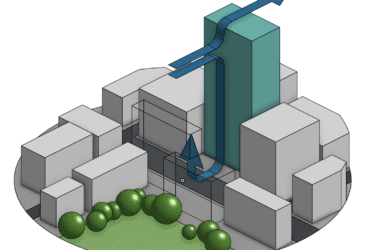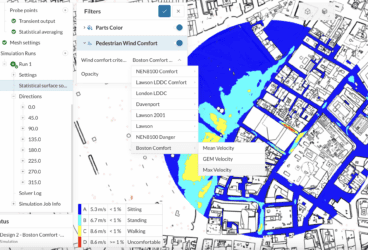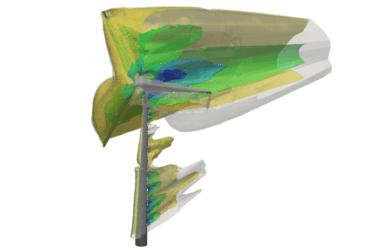Climate change and adaptation commitments are moving at a rapid pace. The built environment has some of the most progressive goals in place driven by sustainable architecture, a push for net-zero energy buildings, and a desire to reduce resource consumption while improving the health and wellbeing of citizens. Many countries, cities, and local authorities will have developed their policy guidance on everything from energy use per m2 per annum to outdoor pedestrian and thermal comfort guidelines.
National building regulations were the genesis for these several decades ago, although they haven’t been able to keep up with the overwhelming desire to go further towards a net-zero carbon built environment. Environmental certification systems such as LEED and BREEAM have been adopted globally and are driving significant progress on improving the environmental, energy, and operational aspects of buildings and cities. They have also been successfully adapted and modified, giving rise to dozens of region-specific rating systems, each one suited to its local climatic and cultural best practices. A recent example of another step forward was the introduction of LEED Zero, for carbon (net-zero operational performance) and resources (energy, water, and waste).
The world is heading towards a net-zero built environment by 2050. It’s a challenging task. Building designers and engineers need powerful and accessible decision-making tools to better understand the complex physics in buildings and the dynamic interaction between nature, the changing climate, occupants, and the built form. Common building simulation tools that model and simulate these variables have been around for decades. It is well understood that for net-zero energy buildings to be realized by 2050, the software tools we use must also improve and scale by an order of magnitude. Such is the task and challenge ahead of us!
Simulation for Zero Energy Buildings
Simulation software tools have evolved over the last 30 years. Early models were simple steady-state calculations used to size heating and cooling loads. These used simple inputs like design weather data points which were fixed to several times of the year. This evolved into dynamic simulation tools where the climate was properly accounted for using annual hourly weather files. This led to whole building simulation software, used to model the thermal, solar, daylight, energy, and ventilation of a building using a 3D model. Many new metrics to design buildings have emerged over the years and have been integrated into software tools as standard outputs we all recognize and use today, for example, the Energy Performance Certificate (EPC) asset ratings or Spatial Daylight Autonomy for daylighting studies. The overall capability has also improved and many simulation tools can now import and calibrate to operational data where the aim is to reconcile design and operational building performance.
There is much still needed, however. We have realized that people, buildings, and cities are extremely complex, dynamic, and unsteady ‘things’. Simplifying their behavior using empirical relationships works to an extent but this approach can also limit our ability to enhance our designs and achieve net-zero energy consumption. Capturing more of the physics is now possible with the advancement in computing capabilities which did not exist 30 years ago. We can also simulate much faster. Where a simulation for a complex city-sized project might have taken days to complete, we can now do the same in a matter of hours. This order of magnitude improvement in speed is critical in allowing designers to analyze multiple design scenarios and start benefiting from optimization algorithms and parallel computing.
The scale of what we model must also increase exponentially. We live in one world yet model the external and internal environment as separate and independent entities. Coupling these two is paramount to being able to correctly capture the impact of nature on our built environment. Scaling up to district and city size models using easy to use digital twin technologies is an emerging technology with huge potential.
Other emerging trends are co-simulation and collaboration. Not every software will be able to do all types of modeling. The simulation landscape is large enough to allow specialist tools that can be used in conjunction to benefit from each other’s unique capabilities. A CFD software tool can be used to simulate the large-scale wind and atmospheric behavior over a city-wide region, the results of which are then imported into a dynamic simulation tool for running indoor thermal comfort and energy simulations. Using public access application programming interfaces (APIs), a designer can now link or integrate multiple simulation tools to achieve the above. Some of the most powerful empowerment and enabling factors for architects, engineers, and simulation experts is to be given the ability and opportunity to create their workflows, using easy to use integrations to powerful simulation tools.
The Evolving Role of Building Simulation and Digital Twins
Integrated Environmental Solutions (IES) is an early pioneer of building simulation and its flagship product, the Virtual Environment (VE) is globally recognized as the leader in building performance and compliance modeling. The VE was one of the first whole building simulation software tools that allowed architects and engineers to consider the wide-ranging environmental impacts of building designs. A user can easily subject the 3D CAD model of their design to climate data and various usage profiles and conditions and see what impact their design choices have on energy consumption, carbon usage, heating and cooling loads, solar gains, daylight availability, and much more.
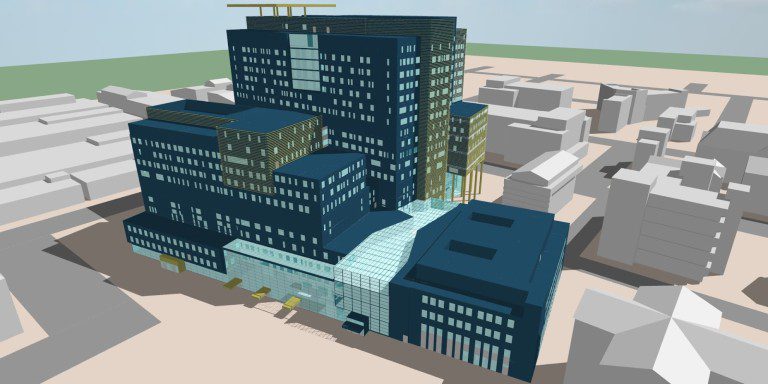
The VE has now been augmented with the release of IES’ Intelligent Communities Lifecycle (ICL) digital twin technology suite that allows users to model the design and operational performance of, not just individual, but entire groups of buildings. Leveraging the combined power of physics-based simulation, real-time operational data, machine learning, and AI, it allows users to simulate city-scale models and subject them to future climate scenarios, changing land-use types, dynamic occupancy profiles, and new technology scenarios. For example, one can begin to model the impact of the load from electric vehicle charging points on the electricity grid over a city-sized area and how this interacts with battery storage at the local building level. The ICL has taken the VE from building level physics to city or even larger scale sustainability and carbon assessments. Sensor data installed in buildings and cities is being used to calibrate these digital twin models in the ICL leading to more predictive capabilities. The ICL is now being used globally to help planners and policymakers develop, test, and implement their design strategies to construct zero energy buildings.
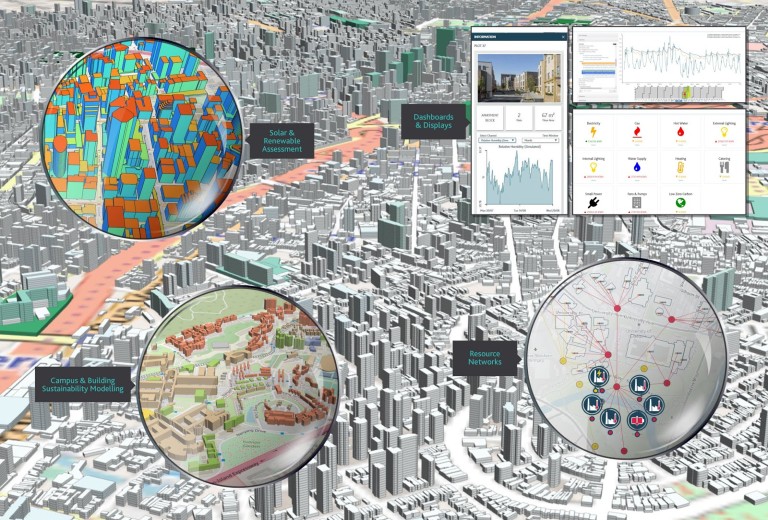
A New Generation of Physics on the Cloud
SimScale GmbH has created the worlds’ first cloud-based engineering simulation platform for computational fluid dynamics (CFD) for the built environment. The SimScale Workbench is accessed through a web browser and is hosted fully on the cloud. This eliminates the need for local hardware, making simulation for zero energy buildings accessible from anywhere in the world.
A new generation of physics solvers based on the lattice Boltzmann method (LBM) has been integrated into SimScale to offer transient simulations for buildings and cities at an order of magnitude greater than traditional CFD software. The LBM method is different from the common finite volume method (FVM) CFD tools and does not require CAD clean-up before importing into SimScale. The solver does not work by solving discretized small volumes of the 3D model, therefore the requirement for water-tight geometry no longer applies. This means entire cities can be simulated for wind comfort, safety, wind loading, and general microclimate analyses in hours rather than days. General-purpose CFD abilities for simulating the indoor environment are also widely available in SimScale. More importantly, SimScale now couples the two types of studies—indoor and outdoor—to give a truer representation of real-world physics.
An urban design simulation to assess how street-level pollution is entering the fresh air supply of a building, whilst also accounting for surrounding buildings, topology, annual wind data, and turbulence is now available to users. Architects and engineers globally are using SimScale to evaluate their designs from the very early models at concept stage, through to detailed engineering and planning assessments.
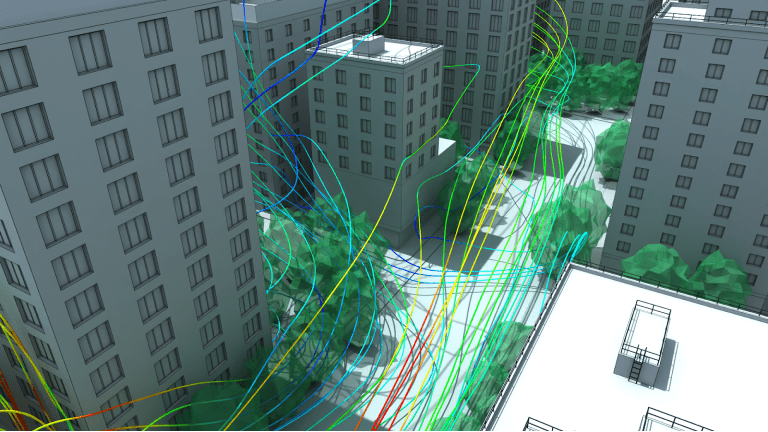
GPU accelerated cloud computing power means that more of the explicit physics is being captured and simulated. Users have access to multiple GPU and CPU cores and can decide what level of simulation power they want to apply. Being hosted on the cloud also means that SimScale is an effective collaboration tool. Multiple team members can now log in and work on the same project and communicate directly through the platform for consulting advice. This ability enables a true co-working and collaborative approach.
Integrated Tools for Zero Energy Building Design
A key feature of both IES and SimScale is that they have publicly available APIs. An IES user, for example, can access the SimScale API and send their VE model to the SimScale platform. SimScale will then perform CFD wind simulations on the model, returning accurate wind pressure coefficients and other data that can be imported and used in the IES thermal and energy simulation. This entire process can be automated using the API and the benefits are clear to see. In the case of a naturally ventilated building, the CFD-generated wind pressure coefficients will add to the quality of the simulation outputs from IES. It will have a significant impact on ventilation, thermal comfort, and hence energy efficiency.
Summary
Simulating for a 2050 world requires major enhancements to the way our buildings and cities are modeled. Some of the outstanding features and technology that are available must be fully leveraged to benefit from them correctly.
Key trends to adopt for simulating a future world of net-zero energy buildings include:
- Co-simulation – combining the physics of CFD with the energy, carbon, and sustainability assessment tools in thermal modeling software;
- Collaboration– making use of APIs to integrate and link multiple specialist software;
- Cloud computing – benefitting from the speed and power of the cloud;
- Scale – moving to city-scale models;
- Operational performance – combining real-world data to calibrate and optimize the model leading to a usable digital twin;
- Skills – helping architects and engineers to fully apply this technology.
About IES
Home to the largest building analytics team in the world, IES has over 2000 years of collective experience. Over the last 25+ years, it has built a solid reputation as the leading innovator in sustainable analytics for the built environment. Utilized globally, the energy and carbon reduction capability of its technology is proven, and with the new ICL platform, its capabilities are expanding from use on individual buildings to helping create entire sustainable communities. Its users average 80,000 projects per year and it is estimated that the use of its technology, to date, has prevented the equivalent of 35+ 500MW power stations from being built, and counting. Learn more at www.iesve.com.

